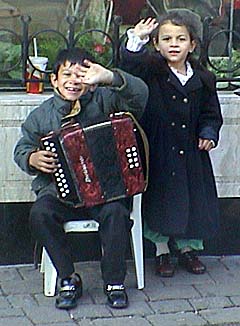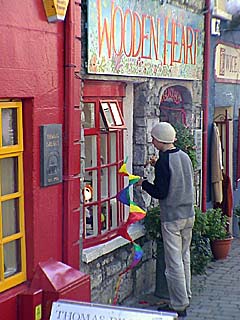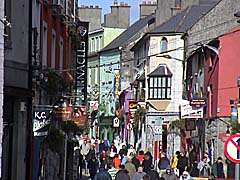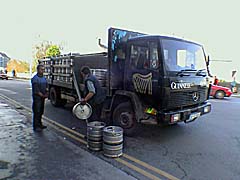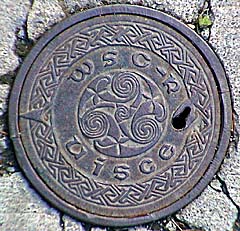
Week 3, part 3
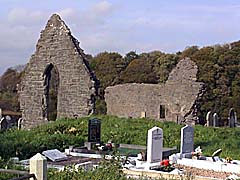 The ruined friary in Donegal town and some of the grave yard surrounding it.
Buskers in Galway came in all ages and ethnicities. These Romany children paused to greet our camera.
We crossed paths with Rachel later on this day.
|
Wednesday's destination was Galway, a university town in about the middle of the west coast of Ireland. On the way, we'd planned to stop in the town of Donegal for a few hours. To see Donegal and still get to Galway before dark, we had to catch a bus at 8:30am. Somehow we slammed down our eggs, bacon, sausages, toast and coffee and made it to the bus station on time. American and Irish buses have one thing in common: an image of a dog in their logos. In the case of Bus Eireann, the dog was an Irish Setter (imagine that). We're waiting to see if a German Shepherd graces the walls of German buses. Our first international border crossing went by almost unnoticed ... we might as well have been crossing an American state line. It wasn't until we were wandering around "Donegal town" (as opposed to "county Donegal") that having moved from the UK to Ireland became an issue ... our British money wasn't any good any more. Changing our folding money into Irish punts was no problem, but our 3.45 pounds worth of coins became souvenirs. Actually, they accidentally became a tip for a guest house hostess later on ... oh well. We got off the bus in Donegal at about 10:50am, and the town's main hotel (the Abbey Hotel) was kind enough to let us store our packs under a staircase near the lobby while we explored the town. We had until 2:40pm to do what we wanted to do. Our main reason for being here was that part of RoZ's family came from this region. According to a family history written by one of her ancestors, "the Scotts came from Ulster, County Donegal. The Donegal Scotts came to Ireland after being 'encouraged' to leave Scotland by King James in the 1600's ..." We didn't learn anymore than that during our brief time in Donegal, but at least we had a chance to visit that region. A few days later, we met a person from Virginia who was also a Scott descendant, and he had a little more information on the family history. Our first hour in Donegal city was spent in a cyber-cafe sending out the week 2 update and engaging in the fight with Earthlink that was outlined above. We took a walk around town from there, walking along the small harbor (which was mostly mud at the time, as the tide was out), visiting the ruins of a Franciscan Friary (built in 1474 and destroyed by the English in 1601), and then taking a lap around the old castle. We came back to the central square (actually more of a triangle), got some Irish cash from an ATM, and then popped into a pub to spend some of that cash on our first pint of Guinness in Ireland. After making some sandwiches for later on, we caught the next bus for Galway. This bus was much more crowded than the one we'd taken in the morning, and we settled into the very back seat. Most of the other riders got off in Sligo, which was the nearest station from which to catch a train to Dublin. Most of the countryside on our ride to Galway was green but barren. We were told that Ireland was once covered with hardwood forests, but they had all been cut down to provide fuel for the industrial revolution. Upon arrival in Galway we were greeted by a sweet but hyper woman who asked us if we were looking for accommodation. We'd read about these keepers of "underground" guest houses, but we'd expected to find them in Prague. She set us up in a room in the center of Galway for 30 punts/night (about $35) including breakfast. The room did not have a sink or TV (so what!), but the location could not have been more ideal. Carmel was a very gracious hostess who tried so hard to keep us happy, she was almost like a doting mother. This brings up an observation we've made on accommodation. Staying in B&B's, guest houses, pensions, etc. is not only a way to save money, it's also a way to enrich your cultural experience, because it's as close as you can get to staying in the homes of the locals. Wednesday night was rather rainy, but we took a walk around anyway, just to get our bearings. We found a bustling High Street (that's what they call "Main Street" in this part of the world) where traditional Irish music eminated (sp?) from the pubs. We popped into one to nurse a pint through a few songs. Outside, some hardy buskers played on in spite of the rain. One of our favorite things about Galway is that most of the center of the city is pedestrianised ... shoppers, buskers, workers, and loiterers can mingle on the streets without having to dodge traffic. Extended pedestrianised areas are common in the best cities we've visited so far. It was still raining when we woke up Thursday morning, but by the time we'd finished breakfast and walked out the door, the skies had cleared up and it was a bright and sunny day. Wishing to save some of our walking energy, we decided to invest in an overpriced "orientation tour" of the town. From the open-air upper level of a vintage double-decker bus, we got to see the parts of Galway we were glad we didn't waste time walking to. After taking a quick lap around the central square, the bus left the center of the city for the top of a nearby hill, where we got to take hazy pictures obscured by power lines. On the way up, our guide - who sounded bored with his job - pointed out all of the suburban housing projects. At the waterfront, we were told of the hundreds of acres of the bay that were filled in for still more cookie-cutter houses. And we got to see construction in progress on a sewage treatment plant on an island where a historic lighthouse once stood. The people who wanted to save the lighthouse had gone to court and lost. After spending an hour listening to Galway's depressing history of construction and demolition and reconstruction, we were reminded of our own city's similar history. Galway may be 500 years old, but most of its historic buildings were torn down 400 years ago. We took a long walk around town to see the more interesting stuff that the bus totally missed. We walked along the canals that branch off the river that runs through town and into Galway Bay. We got a nice daytime look at the pedestrianised central city. And of course we sniffed around the obscure alleyways in search of good deals on food and coffee. Galway is a college town, so that adds to its youthful vigor and attracts a steady flow of young visitors from all over Europe. Thursday night we went to a cyber-cafe, and struck up a conversation with a gent named Paddy, accompanied by his companion Rachel. Rachel had received a few coins from us earlier in the day while she was playing cello on High Street. Paddy was one of the first people we'd met who not only knew where Wisconsin is, but he also knows where La Crosse is. Several years ago he took a bike tour from Chicago to Minneapolis, and had passed through our area. Later on that evening, we huddled around pints and swapped stories of being besieged by raccoons while camping in Wisconsin.
|
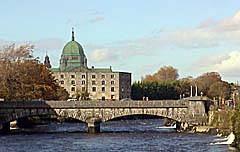 A bridge and the cathedral in Galway.
A painter works to keep a storefront in Galway colorful.
A view of the High Street in Galway.
Some workers collect up empty kegs to be refilled with one of our favorite beverages.
Even the utility covers in Ireland were interesting.
|
Next page ... Previous page
week 3 index
purplearth 2001 europe oddyzee index
purplearth home
